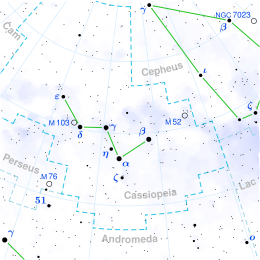HR 511
Appearance
| Observation data Epoch J2000 Equinox J2000 | |
|---|---|
| Constellation | Cassiopeia |
| Right ascension | 01h 47m 44.83s[1] |
| Declination | +63° 51′ 09.0″[1] |
| Apparent magnitude (V) | 5.63[2] |
| Characteristics | |
| Spectral type | K0 V[3] |
| U−B color index | +0.40[2] |
| B−V color index | +0.80[3] |
| Astrometry | |
| Radial velocity (Rv) | +1.41[3] km/s |
| Proper motion (μ) | RA: +582.03±0.35[1] mas/yr Dec.: −246.93±0.43[1] mas/yr |
| Parallax (π) | 99.33 ± 0.53 mas[1] |
| Distance | 32.8 ± 0.2 ly (10.07 ± 0.05 pc) |
| Absolute magnitude (MV) | 5.61[4] |
| Details | |
| Mass | 0.825±0.021[5] M☉ |
| Radius | 0.819±0.024[6] R☉ |
| Luminosity | 0.516±0.010[5] L☉ |
| Temperature | 5407±4.0[7] K |
| Metallicity | 95.5%[8] |
| Metallicity [Fe/H] | −0.02[8] dex |
| Rotation | 21.67 days[9] |
| Rotational velocity (v sin i) | 2[9] km/s |
| Age | 2.3-4[9] Gyr |
| Other designations | |
| Database references | |
| SIMBAD | data |
| ARICNS | data |
HR 511 (also designated V987 Cassiopeiae and Gliese 75 among others) is an orange dwarf of spectral type K0V in the constellation Cassiopeia. With an apparent magnitude of 5.63,[2] it is faintly visible to the naked eye. The star is relatively close, 32.8 light years from the Sun.[1]
This star is estimated to be about the same age as the Sun, with 83% of the mass of the Sun and 82% of the Sun's radius. It has not been identified as a member of any moving star groups. This star has displayed unusual emissions of Ca II and is much more x-ray luminous than the Sun. It is considered a relatively active star.[9] Based on an iron abundance of [Fe/H] = -0.02, the metallicity of this star appears to be similar to that of the Sun.[8]
References
- ^ a b c d e f van Leeuwen, F. (2007). "Validation of the new Hipparcos reduction". Astronomy and Astrophysics. 474 (2): 653–664. arXiv:0708.1752. Bibcode:2007A&A...474..653V. doi:10.1051/0004-6361:20078357.Vizier catalog entry
- ^ a b c Mermilliod, J.-C. (1986), "Compilation of Eggen's UBV data, transformed to UBV (unpublished)", Catalogue of Eggen's UBV Data. SIMBAD, Bibcode:1986EgUBV........0M
- ^ a b c White, Russel J.; Gabor, Jared M.; Hillenbrand, Lynne A. (June 2007), "High-Dispersion Optical Spectra of Nearby Stars Younger Than the Sun", The Astronomical Journal, 133 (6): 2524–2536, arXiv:0706.0542, Bibcode:2007AJ....133.2524W, doi:10.1086/514336.
- ^ Holmberg, J.; et al. (July 2009), "The Geneva-Copenhagen survey of the solar neighbourhood. III. Improved distances, ages, and kinematics", Astronomy and Astrophysics, 501 (3): 941–947, arXiv:0811.3982, Bibcode:2009A&A...501..941H, doi:10.1051/0004-6361/200811191.
- ^ a b Boyajian, Tabetha S.; et al. (February 2012), "Stellar Diameters and Temperatures. I. Main-sequence A, F, and G Stars", The Astrophysical Journal, 746 (1): 101, arXiv:1112.3316, Bibcode:2012ApJ...746..101B, doi:10.1088/0004-637X/746/1/101. See Table 10.
- ^ Demory, B.-O.; et al. (October 2009), "Mass-radius relation of low and very low-mass stars revisited with the VLTI", Astronomy and Astrophysics, 505 (1): 205–215, arXiv:0906.0602, Bibcode:2009A&A...505..205D, doi:10.1051/0004-6361/200911976
- ^ Kovtyukh, V. V.; et al. (2003), "High precision effective temperatures for 181 F-K dwarfs from line-depth ratios", Astronomy and Astrophysics, 411 (3): 559–564, arXiv:astro-ph/0308429, Bibcode:2003A&A...411..559K, doi:10.1051/0004-6361:20031378
- ^ a b c Feltzing, S.; Gonzalez, G. (2001), "The nature of super-metal-rich stars. Detailed abundance analysis of 8 super-metal-rich star candidates", Astronomy and Astrophysics, 367 (1): 253–265, Bibcode:2001A&A...367..253F, doi:10.1051/0004-6361:20000477
- ^ a b c d Gaidos, E. J.; Henry, G. W.; Henry, S. M. (2000), "Spectroscopy and Photometry of Nearby Young Solar Analogs", The Astronomical Journal, 120 (2): 1006–1013, Bibcode:2000AJ....120.1006G, CiteSeerX 10.1.1.43.4478, doi:10.1086/301488
- ^ "HR 511". SIMBAD. Centre de données astronomiques de Strasbourg. Retrieved 2016-07-09.
{{cite web}}: CS1 maint: postscript (link)
External links
- "ARICNS 4C00155". ARI Data Base for Nearby Stars. Astronomisches Rechen-Institut. March 4, 1998. Retrieved 2008-02-27.
- SolStation

